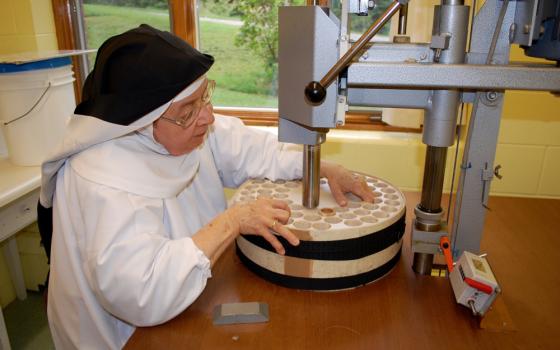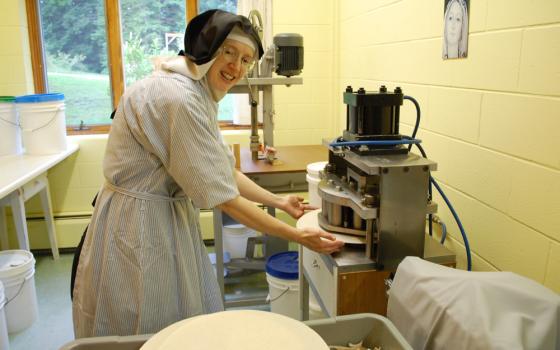It's generally quiet in the Altar Bread Department at the Monastery of the Immaculate Heart of Mary in Westfield as Benedictine nuns in their full habits covered with smocks produce thousands of hosts to be consecrated and distributed to Catholics at the Eucharist.
In keeping with the contemplative lifestyle of their order, the Congregation of Solesmes, there is little talking.
When Sister Marie Anges Martel does her work at the cutting machine by the window, the dominant sound is the hiss and clunk of the machine cutting through layers of whole wheat wafers, which resemble thin pizza crusts.
It is important work, for as Sister Claire-Joseph Desmarais, the altar bread official, said: "We help Jesus bring himself to souls by making altar bread hosts. Through the priest, Jesus brings himself to the people."
She and the two other sisters who work in the department — Sister Marie Anges and Sister Theresa Margaret Hagen — enjoy their work "helping bring Jesus to souls, the real, true bread of life."
It's a process the sisters and their Benedictine Oblate baker and sorter have down pat: Weigh the flour, mix the batter, bake the wafers on five bakers that resemble tortilla presses, sort and store the baked wafers, add flexibility to the crisp discs in the humidity room, cut them into hosts, lay larger ones on blotters to flatten, sort and dry them, weigh and bag them, store them and finally send them to customers in about 16 states — as far away as California and Texas.
But at a time where there is more and more of an emphasis on "buying local," the Benedictine altar bread is more than a local product.
"I can get altar bread from a lot of different [secular] companies. They send me a bill but don't pray for my parish," said Msgr. Richard G. Lavalley, pastor of St. Francis Xavier Parish in Winooski, which uses about 1,000 communicants' hosts a week.
"These nuns are praying for us. I want to keep them in Vermont. They are praying for our diocese and our parishes," he told Vermont Catholic, the magazine of the Diocese of Burlington. "We have to do everything we can to support them," like getting altar bread from them, he added.
He appreciates the fine quality of the hosts and gets the thickest ones because "I want them to look like bread, to taste like bread, to feel like bread."
The Benedictine nuns began making altar bread in 1990 when the Daughters of the Sacred Heart of Jesus in Newport, discontinued their operation and gave them their equipment, including one small baker.
In 1991, the nuns replaced that with four larger bakers; they added a fifth three or four years later.
Some of the bakers have etching on them to imprint crosses on the hosts.
Sister Marie Anges served as altar bread official from 1990 to 2015 but still helps in the Altar Bread Department at the monastery. At first, she worked alone in the department with sorting help from women in the novitiate.
She remembers cutting the larger priests' hosts, those elevated at the consecration, one by one. Now she can cut 14 at a time with updated equipment.
She cuts 45 to 84 communicants' hosts on a different cutter in one cut depending on their thickness.
Baking usually takes place three days a week for a total of six batches a week. One batch produces 160 large round wafers; each wafer yields about 74 communicants' hosts or 14 to 19 priests' hosts.
Out of about 6,000 hosts, about 5,500 are sellable.
Imperfect hosts and the cuttings — the sections of the wafers left after the hosts are cut from them — go to local farmers for pigs and chickens; some of the cuttings are packaged, labeled as "Monastery Manna" and sold in the monastery gift shop for $1 a bag.
The nuns produce about 3 million communicants' and priests' hosts a year. They range in diameter from 1 and 1/8 to 5 and 1/2 inches.
The only ingredients are wheat flour and water; the monastery does not produce gluten-free hosts.
Once they are packaged and ready to mail, the monastery chaplain takes the packages to the post office for the nuns.
Income from the altar bread is used for expenses at the monastery, home to 16 nuns.
"I came here to live life and love God and praise his name," said Sister Claire-Joseph who entered the monastery in 2001. She had filled in for Sister Marie Anges three times before assuming responsibilities as altar bread official. "Working on the altar bread is providing for my family."
The ideal is for the workers in the Altar Bread Department to work in as much silence as possible; any talk should be related to the work.
A former security clerk, she said putting her organizational skills to work in the Altar Bread Department is enjoyable.
Before Sister Claire-Joseph computerized the department, Sister Marie Anges used a manual typewriter for labels and billing.
With Jesus as her spouse, Sister Claire-Joseph said she is "living my spousal relationship on a daily basis" and helping to bring Jesus to her extended family in the church.
The nuns' life is based on "ora et labora" — prayer and work. "When we are not praying or engaged in divine reading we are working," she explained.
"We are not idle," Sister Marie Anges said. "It's beautiful because we work for the Lord. We're close to the Lord in this kind of work."
Sister Claire-Joseph said that as the altar bread production increases, the nuns plan to include other Benedictine Oblates to help as necessary "to keep everything in the Benedictine community."
Without the Oblates' help, "there would be too much baking and we would miss the [Divine] Office" prayers, she explained.
[Cori Fugere Urban is a staff writer for Vermont Catholic, the magazine of the Diocese of Burlington.]

